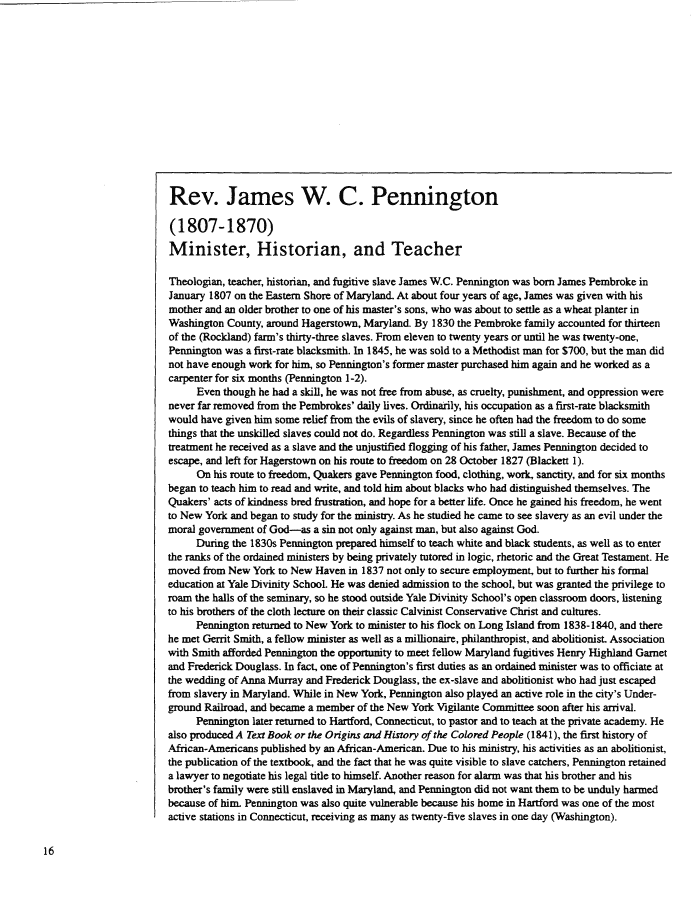 |
||||
|
TASK FORCE TO STUDY THE HISTORY AND LEGACY OF SLAVERY IN MARYLAND (Final Report) 1999/12/31 MdHR 991422 MdHR 991422, Image No: 376 Print image (96K) |
 |
||||
|
TASK FORCE TO STUDY THE HISTORY AND LEGACY OF SLAVERY IN MARYLAND (Final Report) 1999/12/31 MdHR 991422 MdHR 991422, Image No: 376 Print image (96K) |
| Rev. James W. C. Pennington (1807-1870) Minister, Historian, and Teacher Theologian, teacher, historian, and fugitive slave James W.C. Pennington was born James Pembroke in January 1807 on the Eastern Shore of Maryland. At about four years of age, James was given with his mother and an older brother to one of his master's sons, who was about to settle as a wheat planter in Washington County, around Hagerstown, Maryland. By 1830 the Pembroke family accounted for thirteen of the (Rockland) farm's thirty-three slaves. From eleven to twenty years or until he was twenty-one, Pennington was a first-rate blacksmith. In 1845, he was sold to a Methodist man for $700, but the man did not have enough work for him, so Pennington's former master purchased him again and he worked as a carpenter for six months (Pennington 1-2). Even though he had a skill, he was not free from abuse, as cruelty, punishment, and oppression were never far removed from the Pembrokes' daily lives. Ordinarily, his occupation as a first-rate blacksmith would have given him some relief from the evils of slavery, since he often had the freedom to do some things that the unskilled slaves could not do. Regardless Pennington was still a slave. Because of the treatment he received as a slave and the unjustified flogging of his father, James Pennington decided to escape, and left for Hagerstown on his route to freedom on 28 October 1827 (Blackett 1). On his mute to freedom, Quakers gave Pennington food, clothing, work, sanctity, and for six months began to teach him to read and write, and told him about blacks who had distinguished themselves. The Quakers' acts of kindness bred frustration, and hope for a better life. Once he gained his freedom, he went to New York and began to study for the ministry. As he studied he came to see slavery as an evil under the moral government of God—as a sin not only against man, but also against God. During the 1830s Pennington prepared himself to teach white and black students, as well as to enter the ranks of the ordained ministers by being privately tutored in logic, rhetoric and the Great Testament. He moved from New York to New Haven in 1837 not only to secure employment, but to further his formal education at Yale Divinity School He was denied admission to the school, but was granted the privilege to roam the halls of the seminary, so he stood outside Yale Divinity School's open classroom doors, listening to his brothers of the cloth lecture on their classic Calvinist Conservative Christ and cultures. Pennington returned to New York to minister to his flock on Long Island from 1838-1840, and there he met Gerrit Smith, a fellow minister as well as a millionaire, philanthropist, and abolitionist Association with Smith afforded Pennington the opportunity to meet fellow Maryland fugitives Henry Highland Garnet and Frederick Douglass. In fact, one of Pennington's first duties as an ordained minister was to officiate at the wedding of Anna Murray and Frederick Douglass, the ex-slave and abolitionist who had just escaped from slavery in Maryland. While in New York, Pennington also played an active role in the city's Underground Railroad, and became a member of the New York Vigilante Committee soon after his arrival. Pennington later returned to Hartford, Connecticut, to pastor and to teach at the private academy. He also produced A Text Book or the Origins and History of the Colored People (1841), the first history of African-Americans published by an African-American. Due to his ministry, his activities as an abolitionist, the publication of the textbook, and the fact that he was quite visible to slave catchers, Pennington retained a lawyer to negotiate his legal title to himself. Another reason for alarm was that his brother and his brother's family were still enslaved in Maryland, and Pennington did not want them to be unduly harmed because of him. Pennington was also quite vulnerable because his home in Hartford was one of the most active stations in Connecticut, receiving as many as twenty-five slaves in one day (Washington). 16 |